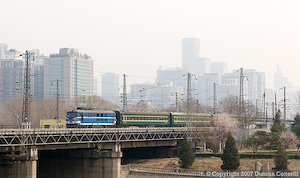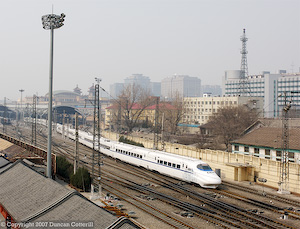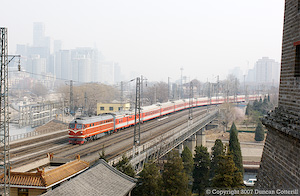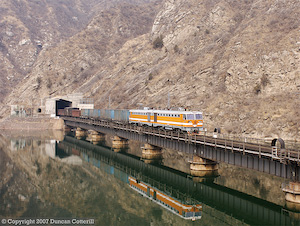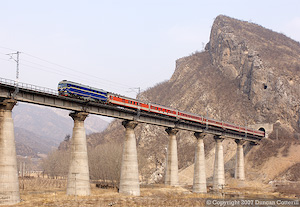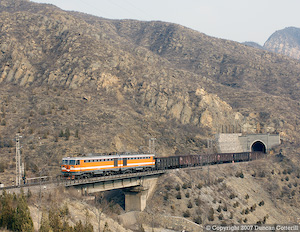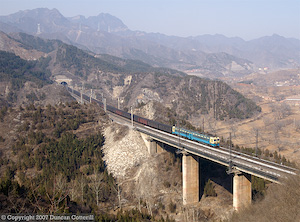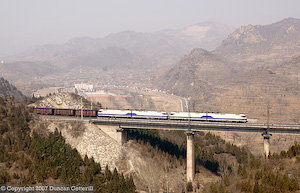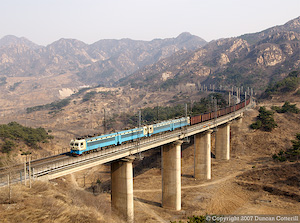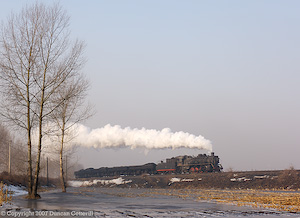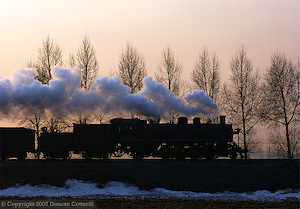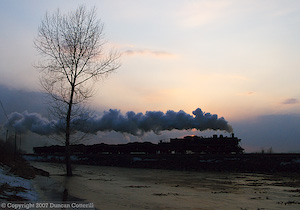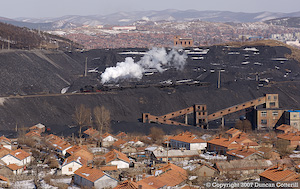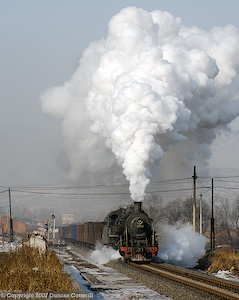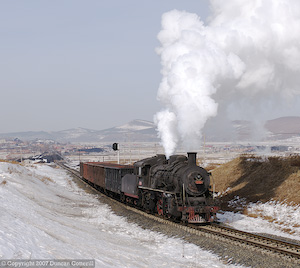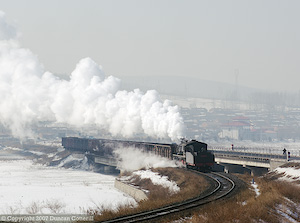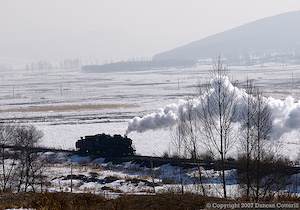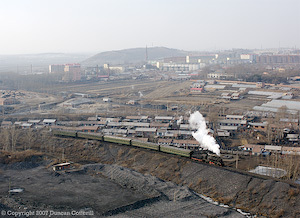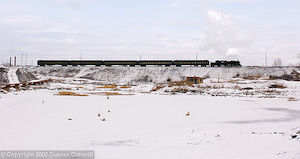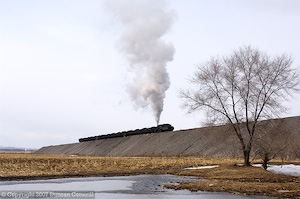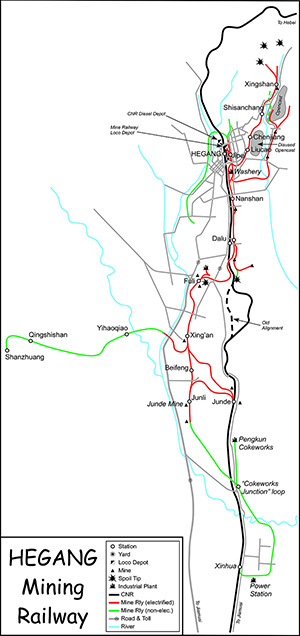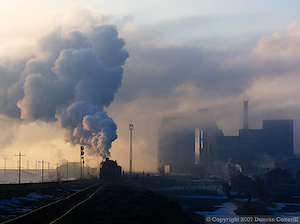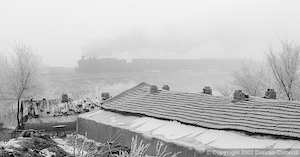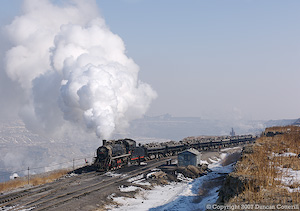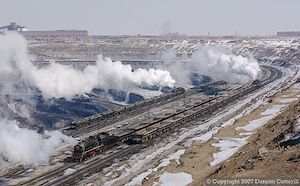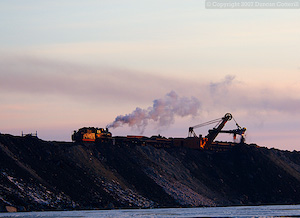Northern Coal Lines
15 - 31 March 2007
Report by Duncan Cotterill
Introduction
A late Spring Festival this year meant that our traditional early March trip to China didn’t get underway until the middle of the month. I went out to Beijing for a few days of modern traction photography around the capital before Beter Breeze and Bryan Acford arrived. We then travelled to the North-East to visit the steam worked colliery lines at Jixi, Hegang and Zhalainuoer. As usual Sun Xiaolan made all the arrangements and accompanied us as guide.
Beijing Zhan
(Thursday 15 March)After arriving at Beijing Airport at 09:30 I travelled into the city centre. The gricing got off to a gentle start with a visit to the Dongnan Jiaolou, the old watchtower that overlooks the approach to Beijing’s main station. With around eight passenger workings per hour plus numerous empty stock and light engine movements there was hardly a dull moment during the four hours spent there.
There were a few surprises including a pair of CRH2 high speed EMUs which arrived on a test run before retiring to the depot. Curiously, the vehicles at both ends of each unit appeared to have identical numbers, e.g. CRH2 027A, although they might possibly be set numbers rather than an individual vehicle numbers but the "A" suffix doesn't make sense in that case.
Another surprise was seeing electric locomotives on Tianjin line workings. Train T36 from Jinan had SS7E 0087 piloting DF11 0400 while SS9 0190 piloted DF11 0401 on T36, the return working to Jinan. The majority of trains on the Tianjin line were diesel worked with NZY2 units on the Tianjin shuttles and either DF4Ds or DF11s on longer distance workings.
Most trains on the Fengrun line were hauled by SS9Gs but 2589 to Jinzhou was a Tangshan allocated SS8 and 1468 from Jiagedaqi had orange DF4 2250. A Spring Festival extra working from Changchun arrived at 13:12 behind another orange DF4. Huairou Bei DF4s worked trains on the Chengde and Chifeng lines. A Fengtai DF4C was on 4415 to Zhangjiakou but 4416 from Zhangjiakou was SS3 hauled.
Of the rarer classes I’d hoped for, only a couple of BJs turned up on empty stock workings and they were both in the first 15 minutes I was there. No NY7s, DF10F, DF11G or DF11Z were seen. The weather was hazy with weak sunshine most of the day.
Luopoling & Yanchi (Feng-Sha line)
(Friday 16 March)Friday dawned cloudy but although the sun broke through mid morning, it remained very hazy throughout. The day was spent on the direct line to Shacheng. This route runs through a spectacular gorge most of the way from the outskirts of Beijing to Shacheng. The scenery is not unlike that at Shidu although the photographic locations aren’t anything like as good in my opinion. The line is nominally double track but could be better described as two parallel single track lines for much of its length. From Sanjiadian, where the line leaves Beijing, to Yanchi the two lines follow the same route but are often a short distance apart and at slightly different levels. West of Yanchi the routes are quite different and, in places, the lines are over a km apart and often on opposite sides of the river valley. The whole route is heavily engineered and makes extensive use of tunnels and bridges to shortcut the river valley’s twists and turns. Where the line is not in tunnel or on bridges, it runs on ledges cut into the mountainsides high above the valley floor.
Freight traffic was heavy in the morning with 3 or 4 freights each way an hour but it dried up in the afternoon with gaps of over half an hour between trains. Much of the traffic was coal bound for the Beijing area. Every freight seen was worked by an 8K Bo-Bo+Bo-Bo electric from Fengtai depot. Most passenger trains were hauled by Fengtai based DF4C, often the early Datong built examples with numbers in the DF4 00xx series that duplicate the original DF4s. The only exception to the DF4C monopoly was train 4416 from Zhangjiakou to Beijing which had an SS3 on the front. One unidentified working was a westbound passenger from Ganzhou to Datong that passed Luopoling at 11:08 and was thought to be a Spring Festival extra.
In addition to the main line there is also a single-track non-electrified branch that follows the valley bottom to Luopoling before heading south to Muchengjian. A DF7B was seen heading along the branch towards Beijing with a short freight around 09:00.
Da-Qin Coal Railway
(Saturday 17 March)This is the 1980s-built double-track electrified railway linking the Datong coalfield directly to the port of Qinhuangdao. The line passes through the mountains north of Beijing on a well engineered alignment liberally endowed with viaducts and tunnels. The railway runs roughly west-east while the area’s roads tend to follow the valleys and run south-north. As a consequence it isn’t very easy to follow the line. I headed initially for Xiazhuang, where the line is close to the road for a reasonable distance, then travelled round to Heishanzhai in the afternoon. Both places are shown on the latest Nelles map of Northern China. Xiazhuang is shown on the Quail atlas as Shangzhuang.
I thought the scenery would be good but I hadn’t appreciated just how busy the line would be. Trains ran every 10 minutes or so in each direction all morning and the pace only slackened a little in the afternoon.
Most loaded trains were either a single SS4G Bo-Bo+Bo-Bo on around 60 C62, C63, C64 or C70 wagons or a pair of SS4Gs on around 120 of the same wagons. Some of the longer trains were double headed while others had the second loco cut in mid-train. One in every 4 or 5 workings was a mega-train comprising an SS4G, around 100 C80 wagons, a pair of SS4Gs, another 100 or so C80s and a fourth SS4G bringing up the rear. These monsters weighed in at around 20,000 tonnes gross and took 4 to 5 minutes to pass.
Things were simpler in the westbound direction. Empty trains were either single or double headed with no mid-train helpers and no bankers. The C80s came back in rakes of around 100 wagons with a pair of SS4Gs and the other wagons in 60 or 120 wagon sets single or double headed respectively.
A number of very modern locos were also seen, probably DJ1 class. These were also Bo-Bo+Bo-Bo types and were only seen in pairs on long trains of conventional wagons. There were around 4 DJ1 worked trains in total compared with over 60 hauled by SS4Gs. Unfortunately I was never close enough to read the numbers on the SS4Gs and couldn’t even see where the numbers were on the DJ1s, if indeed that’s what they were. Depot codes were equally difficult to read although I did recognise Taiyuan Bureau on several SS4Gs.
One unexpected headache was the presence of large numbers of old folk with red armbands by the roadsides charged with preventing people climbing into the hills. It seems they were worried about townies dropping cigarette butts and setting the dry vegetation alight. Fortunately they weren’t very effective at stopping non-smoking gricers and once evaded, they didn’t give chase. The weather was sunny but still very hazy all day.
Beijing – Harbin – Jixi
(Sunday 18 – Monday 19 March)I met up with Bryan and Peter at Beijing Airport on Sunday morning and we flew on to Harbin on HU 7129, scheduled to depart at 14:05 but delayed by over 2 hours. That made our connection into train N27 at Harbin tight but in the event traffic in the town centre was light and we made it with time to spare. N27 was hauled by Sankeshu’s DF4D 3093. Also seen at Harbin were DF11 0143 arriving on an unidentified working from the north, DF4 1774, in orange passenger livery in spite of its number, on 2036 to Tumen and, strangest of all, SS9 0106 double heading DF11 0131 on train T18 to Beijing. Both locos had Beijing shedcodes, so it is assumed they worked the train throughout. The other locos seen had Sankeshu (Harbin) shedcodes. We arrived at Jixi ahead of time at 04:20 on Monday morning.
Jixi Mining Railways
(Monday 19 March – Friday 23 March)The weather was generally reasonable during our stay at Jixi with plenty of sunshine but poor visibility much of the time. Temperatures fell well below zero every night then rose above freezing during the day. By mid morning the frozen ground was turning to thick sticky mud making walking across the fields a very unpleasant process. We also experienced an earthquake of strength 4.5 while in the hotel one evening. The epicentre was just a few miles away at Jidong. Fortunately it didn’t appear to do any serious damage and everything was operating normally the following morning. During our stay we visited four of the five lines in the Jixi area and found all still 100% steam worked.
Chengzihe System
We spent a lot of time at Chengzihe and found it incredibly busy at times and very quiet at others. Loco duties followed the usual pattern with most activity around the Dongchang / Beichang area. Eight different SY were seen in action over the period we were there. The two missing locos were SY 0237 and SY 1437. We learned that SY 0237 had been written off in a level crossing collision with a heavy truck in January and would not be repaired. Unfortunately the loco crew were all seriously injured in the collision and were still in hospital at the time of our visit.
Locos: SY 0590, 0733, 0863, 1018, 1058, 1344, 1351, 1544 in service.
Didao System
Two brief visits to Didao found four SYs in use. Again duties followed the usual pattern with operations centred on the washery complex at Hebei. Activity was sporadic and patience was required to get the better shots.
Locos: SY 0950, 1205, 1213, 1446 in service.
Hengshan System
Again little change to report. The morning procession of trains up the bank from Xinhengshan to Zhongxin appeared as expected on the two mornings we were there. Trains returned from the mines in the late morning and there were usually more uphill trains between 12:00 and 14:00. All trains were single headed and only one out of eight uphill trains observed produced a banker. Seven SYs were seen in action including infrequently reported SY 0898 in its usual hiding place at Erkuang.
Locos: SY 0341, 0746, 0804, 0898, 1095, 1340, 1369 in service.
Lishu System
This line remains quiet but it is the most scenic part of the whole Jixi system and worth a visit for that reason alone. On the day we visited there was a single trip to Pinggang at 09:00 and a trip to Qikeng at 13:00.
Locos: SY 0951, 1118 in service.
Jixi – Huanan - Hegang
(Friday 23 March)Our plan was to visit Huanan if the line was open or go to Hegang if (as expected) it was not. While we were at Jixi , it was confirmed that coal traffic wouldn't resume at Huanan before early April, so we travelled to Hegang on 23 March. The journey by road took around five hours including a break for lunch at Huanan.
Hegang Mining Railway
(Friday 23 – Monday 26 March)Although we had spent a couple of hours at Hegang in 2005, this was our first proper visit to this extensive system. In spite of the large number of visitors over the years, the picture painted by previous reports was confusing and many of the maps published were contradictory. During our stay in the area the weather was far from perfect and we spent a considerable time exploring the system while it was dull. I've drawn a map showing the layout as I understand it (see the filmstrip).
The situation around Junde and Junli is particularly confusing. Junde station is where the mine railway interchanges with CNR south of Hegang. Junde mine is a couple of km west of Junde station adjacent to the mine railway station called Junli. Any references to Junde below refer to the CNR interchange. Junde mine will be referred to as Junli. For a system that runs primarily through an urban area, the line is remarkably inaccessible in places with few good roads parallelling or crossing it.
Passenger trains ran to the expected pattern with a few minor retimings. The current timetable is reproduced further down the filmstrip. Note that there are no trains via Junde and the trains to/from Shanzhuang run in summer only. Trains 24 and 25 on the Xingshan line certainly didn’t run on the Sunday but they are still advertised, so may be weekdays only workings. All the trains on the Junli line ran daily. While most Chinese coaches are heated by individual coal-fired stoves, the rolling stock here is unusual in being steam heated. This may explain why the passengers on Xingshan and Junde lines were steam hauled in spite of running under the wires.
Freight traffic was generally light and mainly electrically worked. The most productive mines appeared to be those at Xing’an and Junli. Both sent their coal out via the CNR connection at Junde. Coal from Nanshan, Dalu and Fuli mines appeared to go south to either Xing’an or Junli for washing as we only saw coal going south and empties going north on this section, all in internal wagons, not CNR ones. Again, electric haulage was the norm. A spoil train from Nanshan going north, some empty side tippers going north from Fuli and some general freight coming off the branch that loops through the north-west of Hegang were the only steam freight workings we saw on the electrified part of the network. Little time was spent on the north side of town and only one train was seen, an electrically worked set of coal empties heading towards Xingshan. South of Junde, down towards the power station and cokeworks, everything was steam but there weren’t many trains. On a good day it appeared that trains could run to the power station every four hours but the gaps in service were often much longer. No trains to or from the cokeworks were seen but the line was definitely in use.
There is still a rail connection into the large opencast pit adjacent to Xingshan but it connects with the line on the east side of the pit, not the Xingshan line. There didn’t appear to be much rail activity in the pit itself but the rails leading into the hole were shiny and clear of snow indicating that the line was still in use. The closed opencast site closer to the city wasn’t investigated.
The climb from Fuli towards Dalu and the embankment leading to the CNR crossing on the power station branch appeared to be the best photographic locations on the system but neither saw much traffic.
Most steam locos faced north but there were exceptions including SY 3013 on a train to the power station on the Friday. The locos seen on the passengers always faced north at Jipei. SY 1498 appeared to be the regular passenger loco on the Junde trains although SY 3014 was seen on one of the Friday workings. Generally locos looked run down and dirty including the decorated and previously well-kept SY 1498.
Most electric working appeared to be handled by the smaller (Bo-Bo) locos although several of the larger (Bo-Bo-Bo) engines were seen working coal trains from Xing’an and Junli into Junde.
Steam Locos:
SY 0635, 0799, 0905, 1030, 1464, 1498, 1685, 3013, 3014 in service.
SY 0498, 1370 cold but probably serviceable.
SY 0683, 3023§, 3024 dumped.
Electrics:
2303, 2305, 2306, 2308, 2313 in use.
1422, 1430 dumped.
§ only identifiable from tender number.
Hegang Passenger Timetables
Hegang Jipei - Junli Timetable |
||||||
1 |
3 |
5 |
7 |
9 |
11 |
|
| Jipei | 0600 | 0830 | 1335 | 1601 | 1835 | 2200 |
| Nanshan | 0606 0609 | 0836 0838 | 1341 1343 | 1607 1609 | 1841 1842 | 2206 2208 |
| Dalu | 0615 0618 | 0844 0846 | 1349 1351 | 1615 1617 | 1848 1849 | 2214 2216 |
| Fuli | 0628 0631 | 0856 0858 | 1401 1403 | 1627 1629 | 1859 1900 | 2226 2228 |
| Xing'an | 0638 0641 | 0905 0907 | 1410 1412 | 1636 1638 | 1907 1908 | 2235 2237 |
| Beifang | 0648 0649 | 0915 0917 | 1419 1420 | 1645 1646 | 1915 1916 | 2244 2245 |
| Junli | 0653 | 0921 | 1424 | 1650 | 1920 | 2249 |
Junli - Hegang Jipei Timetable |
||||||
2 |
4 |
6 |
8 |
10 |
12 |
|
| Junli | 0703 | 0931 | 1444 | 1726 | 1930 | 0115 |
| Beifang | 0707 0708 | 0935 0937 | 1448 1449 | 1730 1731 | 1934 1935 | 0119 0121 |
| Xing'an | 0715 0717 | 0944 0946 | 1455 1457 | 1738 1740 | 1942 1943 | 0128 0130 |
| Fuli | 0724 0726 | 0953 0955 | 1504 1509 | 1747 1749 | 1950 1951 | 0137 0139 |
| Dalu | 0736 0738 | 1005 1007 | 1519 1521 | 1759 1801 | 2001 2002 | 0149 0151 |
| Nanshan | 0744 0746 | 1013 1015 | 1527 1529 | 1807 1809 | 2008 2009 | 0157 0159 |
| Jipei | 0752 | 1021 | 1535 | 1815 | 2015 | 0205 |
Hegang Jipei - Xingshan & vv Timetable |
||||||
21 |
23 |
25 |
22 |
24 |
26 |
|
| 0640 | 1418 | 1619 | Jipei |
0747 | 1607 | 1748 |
| 0646 0647 | 1424 1425 | 1627 1629 | Liucao |
0741 0740 | 1601 1600 | 1742 1740 |
| 0649 0651 | 1427 1429 | 1631 1633 | Chenjiang |
0738 0736 | 1558 1556 | 1738 1736 |
| 0657 0659 | 1435 1437 | 1639 1641 | Shisan chang |
0730 0728 | 1550 1548 | 1730 1728 |
| 0709 | 1447 | 1651 | Xingshan |
0720 | 1540 | 1720 |
| Hegang Jipei - Shanzhuang & vv Timetable (summer only) |
||||||
0730 |
1420 |
Jipei |
0958 |
1652 |
||
0736 0737 |
| | |
Nanshan |
| | |
1646 1645 |
||
0743 0755 |
| | |
Dalu |
| | |
1639 1638 |
||
0805 0806 |
| | |
Fuli |
0936 0935 |
1628 1616 |
||
0820 0821 |
| | |
Yihaoqiao |
| | |
1602 1601 |
||
0828 0829 |
| | |
??? |
| | |
| | |
||
0838 0839 |
1510 1511 |
Qingshishan |
1916 0905 |
1546 1545 |
||
0844 |
1516 |
Shanzhuang |
0900 |
1540 |
||
Hegang Area CNR
(Friday 23 – Monday 26 March)Passenger traffic in the Hegang area was mainly in the hands of DF4DKs from Sankeshu depot in Harbin, although one train hauled by a green DF4B was also seen. Freight traffic was worked by Harbin allocated DF4B and DF4C class locos. The pilots at Hegang, Dalu and Junde were DF5s, also allocated to Harbin. Much of the coal traffic originated at Junde and a good proportion of the freights started and finished there with the locos continuing to and from Hegang light engine. Unusually numbered DF4C 2003 was seen at Hegang. Most DF4C don’t carry the “C” suffix on the loco but 2003 is a duplicate of an earlier passenger DF4 number so that may explain it in this case.
Hegang – Jiamusi – Harbin – Zhalainuoer
(Monday 26 – Tuesday 27 March)We left Hegang by road and travelled to Jiamusi. There we boarded train 1490 for the journey to Harbin behind DF4D 3018. Most of the passenger trains passed were also hauled by DF4DKs but a couple were seen with orange DF4Bs in charge. Freight traffic was worked by a mixture of DF4B and DF4C locos with the DF4Cs predominating. All the DF4Cs were in the standard blue and cream livery and none carried the more attractive all over blue seen in small numbers elsewhere. Passing Nancha a freight was seen climbing the celebrated bank on the Wuyiling branch with a single DF4B on the front and two more banking. Station pilots at Jiamusi, Nancha and other points along the line were DF5s.
The timber industry still seemed to be very much in business with the wood yards at places like Langxiang and Xinglongzhen piled high with logs, all presumably now brought in by truck.
At Harbin we transferred to train N91 for the overnight journey to Zhalainuoer. Nothing much was observed before dawn, by which time we were close to Hailaer. All the passenger trains seen were worked by Sankeshu based passenger DF4Ds. Freight traffic seen en-route (and subsequently while at Zhalainuoer) was shared by DF4Bs and DF8Bs from Qiqihaer depot with DF4Bs workings by far the majority. Double headers were common with every combination except double DF8Bs observed. Double DF4Bs were the most frequent pairing. A few long eastbound trains were seen with a pair of DF4Bs at the front and a third cut in midway along the train. Freight traffic was heavy with many block trains of oil tanks and timber, presumably from Russia, as well as coal from Zhalainuoer and general freight. The long line of stored BJs previously noted at Hailaer depot is still there.
The single track west of Hailaer is in the process of being doubled and re-aligned with much work in evidence all along the route. East of Hailaer has been double track for some time.
Zhalainuoer (Jalainur) Mining Railway
(Tuesday 27 – Saturday 31 March)The opencast operation seemed quieter than on previous visits with very little coal being moved. Spoil traffic varied and we experienced both busy and quiet periods. There is still a fair amount of coal left to extract and fairly major excavations were underway at the north end and partway along the pit. As before, spoil trains were usually worked by locos at the north end of the rake coupled chimney to the train but very occasionally one would be coupled to the south end of the train making chimney first pictures possible. Coal trains were worked by locos coupled to the south end of the rake and would have provided far more chimney first opportunities if they had actually been running. Variety was added by the various cranes, tracklaying, stores, explosives and passenger trains.
In contrast, the system serving the deep mines seemed busier than previously and the vast majority of empty wagons delivered by CNR were taken to the deep mines for loading. Several banked trains were seen on the line from the northern collieries, which climbs steeply up to Daqiao. Unfortunately all the locos on the deep mine system face west and these uphill workings were always tender first.
The weather was reasonably good for our first three days although early mornings were foggy and it took a long time for the pit to clear. The south-easterly wind was a great help as it enabled us to get many of the photographs that had eluded us in the past. After a dull, snowy fourth day, the sky cleared for our final morning but the wind had swung round to its usual northerly/northwesterly direction making morning photography difficult.
Opencast System Locos:
SY 0682, 0794, 0959, 1119, 1240, 1257, 1258, 1285, 1286, 1303, 1371, 1374, 1376, 1401, 1450, 1496, 1600, 1650, 1654, 1663, 1664, 1678, 1681, 1689, 3005 in service.
SY 0957, 1690 heavy overhaul.
SY 0471, 0613, 0614, 0795, 0867, 0958, 1041, 1192, 1193, 1256, 1284, 1375, 1449, 1586, 1587, 1601, 1617, 1619 Dongzhan store.
Deep Mine Locos:
SY 0924, 1126, 1416, 1424, 1448, 1618, 1688 in service.
SY 1234 Daqiao store.
Assuming that the boiler and frames parked outside the workshops were the remains of SY 0056, previously dumped at Daqiao, then that accounts for all 54 locos based at Zhalainuoer and means that nothing is away at works. The two locos undergoing a heavy overhaul were being intensively worked on and it’s possible that Zhalainuoer is now overhauling everything itself, rather than sending a proportion of its fleet to Sujiatun for repair.
On the Friday, SY 0958 and SY 1284 were hauled away from Dongzhan. Where they went is unclear and they didn’t appear to be in the shops on Saturday morning. These two looked in the best condition of the locos in store. SY 1041, 1256, 1449, 1587 and 1617 also appeared to be in reasonable condition and capable of being returned to service at relatively short notice. Some of the other locos have been in store for several years and seem unlikely to run again.
Zhalainuoer – Hailaer – Beijing
(Saturday 31 March)Just as the sun got too high and too head on and we were thinking of leaving the pit, another bunch of gricers appeared. When several of them started wandering about in the middle of our shot in brightly coloured clothing, it was definitely time to go.
We travelled by road from Zhalainuoer to Hailaer on the Saturday afternoon. The road conditions were still bad in places after the previous day's snowfall. The road itself has been massively improved over the last few years and the journey was completed in just over three hours. In Hailaer, we didn't see any Sentinel steam buses although the roadside watering facilities were still in place.
We had originally planned to fly back from Manzhouli on Saturday morning but the flight was cancelled. The next best option was a mid afternoon flight from Hailaer, which was also cancelled. We turned up at Hailaer Airport at 18:00 for a 20:10 flight and found the place totally deserted apart from a few confused passengers. No information, no staff, no lights, no indication whatsoever that there would be a flight that evening. Around 19:30 a busload of staff arrived and it all became clear – the flight had been retimed to 22:05 without anyone being told. We finally arrived at Beijing around midnight.
Conclusions
For modern traction fans, the Dongnan Jiaolou in Beijing is a good place to start a trip to China. Although it’s not the greatest photographic location, you can get reasonable pictures there and it’s hard to beat the variety of diesels and electrics on view including, if you are fortunate, endangered classes like the BJ and unusual engines like the DF11Z. The watchtower itself is a haven of peace in the bustling city, where you can relax, recover from your jetlag and just watch the trains.
The line through Luopoling is certainly busy and the 8Ks photograph well in their bright orange livery. However, the section east of Yanchi is not particularly easy to photograph as the second track is usually awkwardly positioned. This is not an issue west of Yanchi but you do only get trains in one direction. Although it’s not the most photogenic line in China, there are enough reasonable positions and you won’t see the unique 8Ks anywhere better.
I’ve seen some heavily trafficked lines in China but nothing to compare with the Datong-Qinhuangdao coal railway. Assuming the volumes seen were typical then the line must be carrying almost one million tonnes of coal every day, a phenomenal amount by any standards. The line itself is very scenic and easily accessible from the capital by road. Although the traction is a bit uniform, the SS4Gs are quite attractive engines and their blue and cream livery stands out well against the countryside in summer or winter. The DJ1s look a bit plastic for my taste but they do add variety and fortunately there aren’t too many of them around yet. It might be wise to visit outside the dry season when there are less likely to be restrictions on access to the hillsides.
Further north in Harbin Bureau, everything seemed stable on the motive power front. There did appear to be a slight decrease in the use of DF4DKs on stopping passengers following the transfer of some of Sankeshu’s locos to Xining but they were wasted on locals anyway. The result appears to be a welcome increase in the use of orange DF4Bs although some are repainted freight locos rather than the proper passenger DF4s. The depot structure appears to have undergone further rationalisation and there may now only be four major depots serving the bureau, i.e. Harbin, Sankeshu, Mudanjiang and Qiqihaer.
On the steam worked coal lines in the North-East, imminent dieselisation is the major issue. Both Hegang and Jixi are expecting their first diesels around May 2007.
Jixi was still a rewarding place to visit in Spring 2007 although the standards of cleanliness had slipped noticeably in the months since my last visit. The locos did still seem to be mechanically sound and we saw some storming performances on the gradients. In spite of this being my fourth visit, we still managed to find a number of new positions and there are some others that will probably never be done now. One rumour that we heard was that the Chengzihe system would be electrified rather than dieselised over the next couple of years. The diesels on order were said to be predominantly for Hengshan. Whatever the truth, JIxi won't be the same once the diesels arrive in May.
Hegang appeared to be doing the absolute minimum required to keep its SYs going until the new diesels arrive and many locos were filthy. However that fits in well with Hegang itself. In spite of my best efforts, I couldn’t really warm to the place, it just didn’t have enough attractive locations and the thick slimy black mud everywhere didn’t help endear it. We did find a few good locations but came away with the impression that there weren’t many more worth looking for. Apart from the passengers, there weren’t any reliable steam hauled workings anyway. Even the non-electrified line south to the power station was paralleled by lines of poles for much of its length and apart from the famous embankment there were few locations of note.
It won’t take many diesels to finish steam at Hegang as the majority of work is either already done by electric locos or could be done by electrics without too much difficulty. It will be interesting to see how the coaches are heated next winter but I don’t expect there will be any visitors to find out. I’m really glad I went and got a few phots but I won’t be too upset when it finishes.
Zhalainuoer appears to be safe from dieselisation for the time being at least but the levels of steam working will almost certainly decline over the next few years as the main opencast coal seam is worked out. However, there isn’t anywhere better to see or photograph working steam in action in 2007 and anyone who hasn’t been should make it a top priority while activity is still at the current level. Where else can you get two, three or occasionally four steam worked trains in the same picture?
Overall, the outlook for the remaining steam operations in China is pretty bleak. Hegang can probably be written off from May this year and Jixi, currently one of the very best locations, will soon be a shadow of its former self with a dozen diesels at work. Elsewhere, Meihekou appears to be a lost cause and many other steam lines doubtless won’t last much longer. For operations like Zhalainuo’er and Sandaoling, the short term prospects are reasonable but they are unlikely to last for more than a few years. This really is the last call for real working steam. Go soon or regret it forever!
Fortunately for railway, as opposed to purely steam enthusiasts, China’s railways continue to expand at a breathtaking rate. The variety of classes that can be seen is incredible and new designs are appearing every year while rapidly growing traffic levels require many of the old diesels and electrics soldier on well past their normal retirement dates. China is where the exciting railway action is in the early years of the 21st Century. It’s got loud diesels, fantastic scenery, incredibly busy electric lines, proper passenger trains, friendly people, superb food, sunny weather and thick black sticky mud. What more could any railfan ask for?
The weather can be pretty awful in the North-East in late March but we got a fair amount of sunshine although it was often hazy. We only had two completely cloudy days. Most of the bad weather occurred while we were at Hegang but we still managed one clear morning and one clear afternoon in the three days we were there. It was still cool enough for white exhausts all day at each location we visited.
Thanks to Robin Gibbons for information about the Da-Qin line and to David Kitching for making me feel guilty about writing off Hegang in the past and then providing directions to an excellent restaurant where we could drown our frustrations in glasses of fine dark beer. I’m glad we gave Hegang another go in spite of the difficulties. Nice beer, shame about the trains.
Finally, it was surprising to see so few other enthusiasts while visiting some of the best steam locations left in the world today. It was good to see Frank Pilchowski again at Jixi after a gap of several years. Frank and his companion were the only gricers we actually met by the lineside although we did exchange greetings with Nick Lera in the lobby of the Capital Airport Hotel as he rushed to catch his bus. The less said about the dayglow plague at Zhalainuoer the better. I think we managed to aviod catching the dreaded fluorescent jacket disease, however Bryan has been exhibiting some worrying symptoms .....
